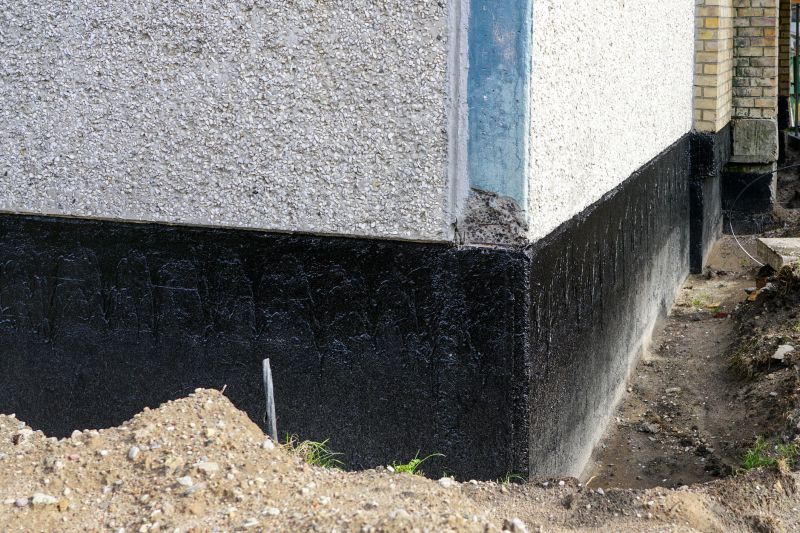Top Waterproofing Products for Long-Lasting Protection
Discover the leading waterproofing solutions designed to safeguard your property from moisture and water damage effectively.
 Waterproofing products are essential for protecting various structures and surfaces from water intrusion and damage. Whether you are sealing a basement, waterproofing a roof, or safeguarding concrete surfaces, choosing the right products can significantly enhance durability and longevity. These solutions come in multiple forms, including liquid coatings, membranes, sealants, and tapes, each designed for specific applications and surfaces. Proper application and selection are crucial to ensure effective water resistance and to prevent issues such as leaks, mold growth, and structural deterioration.
Waterproofing products are essential for protecting various structures and surfaces from water intrusion and damage. Whether you are sealing a basement, waterproofing a roof, or safeguarding concrete surfaces, choosing the right products can significantly enhance durability and longevity. These solutions come in multiple forms, including liquid coatings, membranes, sealants, and tapes, each designed for specific applications and surfaces. Proper application and selection are crucial to ensure effective water resistance and to prevent issues such as leaks, mold growth, and structural deterioration.
Top Overall Option
Multi-Purpose Waterproofing Coating
A versatile waterproofing coating designed for a variety of surfaces including concrete, wood, and masonry. It offers a flexible, durable barrier that resists water penetration and adheres well to different substrates. Suitable for both indoor and outdoor applications, it provides an effective solution for protecting structures against moisture damage over time.
Types of Products For Waterproofings
Liquid Waterproofing Membranes
Fluid coatings that form seamless, flexible barriers on roofs, decks, and foundations, ideal for complex surfaces.
Bituminous Coatings
Asphalt-based coatings suitable for roofing and below-grade waterproofing, providing a durable, weather-resistant layer.
Polyurethane Sealants
Elastic sealants used to fill joints and cracks, offering strong water resistance and flexibility.
Rubberized Waterproofing Sheets
Flexible sheets that create a waterproof layer on flat roofs, basements, and tunnels.
Acrylic Waterproof Coatings
Water-based coatings suitable for walls and roofs, providing a breathable, waterproof surface.
Cementitious Waterproofing
Ready-mixed cement-based coatings ideal for bathrooms, basements, and water tanks.
Waterproofing Tapes
Self-adhesive tapes used to seal joints, cracks, and seams in various structures.
Crystalline Waterproofing
Chemical treatments that penetrate concrete and form a waterproof crystalline structure inside.
Sealant Gels
Viscous gels used to seal around windows, doors, and pipes to prevent water ingress.
Waterproofing Paints
Specialized paints that provide a waterproof layer on exterior walls and surfaces.
Hydrophobic Coatings
Nanotechnology-based coatings that repel water on contact, suitable for various surfaces.
Spray-On Waterproofing
Aerosol or spray-applied solutions for quick and easy waterproofing of small areas.
Epoxy Waterproof Coatings
High-strength coatings used for concrete floors and tanks to provide waterproofing and chemical resistance.
Popular Choices
Widely used for various roofing and foundation projects due to their seamless application.
Commonly selected for roof and below-grade waterproofing applications.
Popular for sealing joints and cracks in both residential and commercial structures.
Favored for quick repairs and sealing small gaps in various surfaces.
Chosen for exterior wall protection due to ease of application and breathability.
Preferred for bathrooms, water tanks, and basements because of its compatibility with concrete.
Selected for concrete structures that require internal waterproofing solutions.
Commonly used around windows, doors, and plumbing fixtures for effective sealing.
Popular for exterior walls and surfaces needing an added layer of water resistance.
Gaining popularity for their water-repelling properties on multiple surfaces.
Convenient for small repair jobs and spot waterproofing tasks.
In residential settings, waterproofing products help protect foundations, crawl spaces, and balconies against moisture penetration. For commercial or industrial projects, specialized membranes and sealants are often employed to withstand harsher conditions and heavier water exposure. It is important to consider factors such as the type of surface, environmental conditions, and the extent of water exposure when selecting waterproofing materials. Regular maintenance and inspections can also prolong the effectiveness of these products, ensuring that structures remain dry and secure over time.
Choosing the appropriate waterproofing solution involves understanding the specific needs of your project. Some products are designed for interior use, providing a barrier against moisture that comes from within or from minor leaks. Others are formulated for exterior applications, where they must withstand weather elements like rain, snow, and UV rays. Proper surface preparation, such as cleaning and drying, is essential before applying waterproofing materials to maximize adhesion and performance. Consulting with professionals or thoroughly researching product specifications can help you make informed decisions tailored to your specific requirements.
Key Buying Considerations
- Identify the specific surface type and choose compatible waterproofing products.
- Consider the environmental exposure, such as UV rays, rain, and temperature fluctuations.
- Determine whether the application is interior or exterior to select appropriate formulations.
- Evaluate the product’s ease of application and drying time to fit your project schedule.
- Review the product’s flexibility and durability for surfaces that may experience movement or expansion.
- Check for compatibility with existing materials and coatings to ensure proper adhesion.
- Assess the level of water resistance needed based on the severity of exposure.
- Consider the longevity and maintenance requirements of the waterproofing solution.
- Ensure proper surface preparation, including cleaning and drying, before application.
- Verify if the product is suitable for the specific thickness or coverage area required.
- Look into the safety data and handling instructions to ensure safe application.
- Determine if the product is suitable for DIY application or if professional installation is recommended.
- Review warranty or guarantee options for added peace of mind.
- Compare costs and coverage to find a balance between budget and effectiveness.
- Check for any specific application instructions, such as temperature or humidity restrictions.
